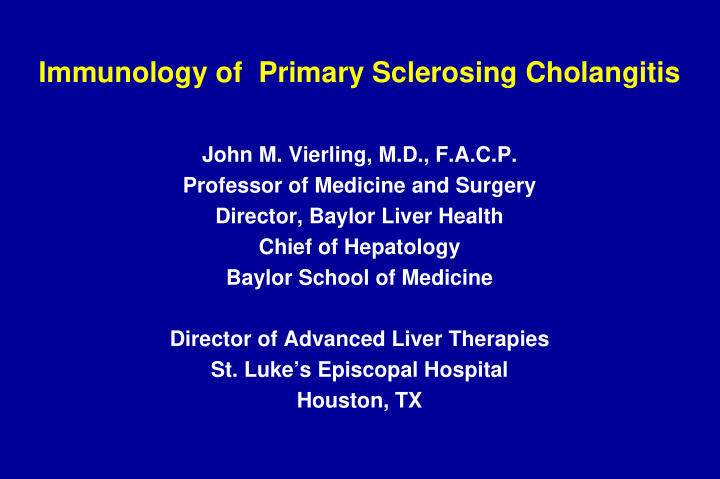



Immunology of Primary Sclerosing Cholangitis John M. Vierling, M.D., F.A.C.P. Professor of Medicine and Surgery Director, Baylor Liver Health Chief of Hepatology Baylor School of Medicine Director of Advanced Liver Therapies St. Luke’s Episcopal Hospital Houston, TX
Anatomy of Bile Ducts
Artery Portal Vein Anatomy of Bile Ducts Duct Bile
ERC Pathology Primary Sclerosing Cholangitis
Pathology of Primary Sclerosing Cholangitis Small Ducts Medium Ducts
Pathology of Primary Sclerosing Cholangitis Blood Vessels Pushed Away from Bile Ducts Small Ducts Medium Ducts
Past Antibodies (Vaccinations, Responses to infections) Antigen Response Cell Mediated Killing (Viruses, Tumors, Rejection of transplanted organs Present Antigen Response
Immunology of Primary Sclerosing Cholangitis The Three “Rs” Your immune response has 3 functions: � Recognize � Respond � Remember
Immunology of Primary Sclerosing Cholangitis Your immune response: � Recognize: � Foreign antigens � Avoid self antigens (autoantigens)
Immunology of Primary Sclerosing Cholangitis Your immune response: � Respond: � Innate immune response � Immediate “ready to go” response � Triggered by molecules on bacteria, viruses, tumor cells � Influences adaptive immune responses � Adaptive immune response
Immunology of Primary Sclerosing Cholangitis Your immune response: � Respond: � Adaptive immune response � Small, processed proteins (antigens) � Presentation of antigens by HLA molecules to T cells and B cells � Activation of T and B cells to antigens
Immunology of Primary Sclerosing Cholangitis Your immune response: � Respond: � Important to: � Regulate both magnitude and duration � Shut off response once it has served it purpose
Immunology of Primary Sclerosing Cholangitis Your immune response: � Respond: � Self or autoantigens= autoimmunity � Break in self-tolerance � As if self were foreign
Innate Immune Response Part One Fragments of dead cells Special Proteins Particles: � Attract inflammatory cells � Bacteria � Intensify inflammation � Viruses � Increase destructive � Bacterial DNA adaptive immune response Antibodies bound to proteins
� Cells under stress Recognize and Kill � Infected cells � Tumor cells Innate Immune Response Part Two Natural Killer Cells
Adaptive Immune Response CD4 Th2 CD4 Antigens Th0 B7- CD28 CD4 Antigen Th1 Presenting NK Cell B 7 - C D 2 8 CD8 CD8 CTL
Immunogenetics in PSC II III I Class HLA B C A DP DQ DR CD4 Th2 CD4 Antigens Th0 CD4 Antigen Th1 Presenting NK Cell CD8 CD8 CTL
Immunogenetics in PSC II III I Class HLA B C A DP DQ DR CD4 Susceptibility Th2 CD4 Antigens Th0 CD4 Antigen Th1 Presenting NK Cell CD8 CD8 CTL
Immunogenetics in PSC II III I Class HLA B C A DP DQ DR C’4, 2, C4AQ0, MICA, HSPs, TNF α/β Antigen Antigen
Adaptive Immune Response CD4 Innate Th2 Immune IL-4 Response CD4 Antigens Th0 B7- CD28 IFN γ CD4 Antigen Th1 Presenting NK IL-2 Cell B7-CD28 CD8 CD8 CTL
Adaptive Immune Response IL-4 Antibodies B CD4 B (Autoantibodies) Th2 IL-4 CD4 Antigens Th0 B7- CD28 IFN γ CD4 Antigen Th1 Presenting NK IL-2 Cell IFN γ B MAC 7 - C D 2 8 Cell-Mediated Killing CD8 CD8 CTL
Immunogenetic Associations in PSC II III I Class HLA B C A DP DQ DR Complement, MICA, HSPs, TNF α/β Susceptibility OR • B8-TNFA*2-MICA*008-DRB3*0101-DRB1*0301-DQA1*0501 DQB1*0201 2.69 • DRB3*0101-DRB1*1301-DQA1*0103-DQB1*0603 3.80 • DRB5*0101-DRB1*1501-DQA1*01102-DQB1*0602 1.52 • MICA*008 5.0 Resistance • DRB4*-DRB1*0401-DQA1*0301-DQB1*0302 0.26 • DRB4*-DRB1*0701-DQA1*0201-DQB1*0303 0.15 • MICA*002 0.12 Donaldson PT, Norris S. Autoimmunity 2002; 35: 555-64; Neri, et al: Dig Liver Dis 2003;35: 571-6; Sheth S, et al. Hum Genet 2003; 113: 286-92; ter Borg PC, et al: Neth J Med 2004; 62: 326-31; ERi R, et al: Genes Immun 2004; 5: 444-50; Yang X, et al: J Hepatol 2004; 40: 375-9
Is PSC an Autoimmune Disease? Comparison of Classical Autoimmunity and PSC Classical Autoimmunity PSC • Females more than males No • Afflicts children & adults Yes • HLA susceptibility associations Yes • Autoantigen(s) No • Autoantibodies or cell-mediated reactions to No autoantigens • Associated with other “immune diseases” Yes • Responds to immunosuppression treatment No
Rat Model of Small Bowel Bacterial Overgrowth � Mutanolysin � Palmitate Peptidoglycan-polysaccahride (PG-PS PAMP) • Small Bowel Overgrowth • Genetically susceptible rats Lichtman SN, et al: J Clin Invest 1992; 90: 1313-22
Immune Mechanisms in Sclerosing Cholangitis Spontaneous Sclerosing Cholangitis in Mdr2 -/- Mouse Fickert et al., Gastroenterology 2002; 123: 1238
Immune Mechanisms in Sclerosing Cholangitis Spontaneous Sclerosing Cholangitis in Mdr2 -/- Mouse � Genetic cause of bile leak between bile duct lining cells � Bile triggers innate immune inflammation and adaptive immunity � Innate immune cells produce inflammatory chemicals � These chemicals activate cells to form scar around the bile duct � As the scar thickens, blood vessels pushed away from the bile duct � Shrinkage of the lining cells of the bile duct due to lack of oxygen and nutrition supplied by D Fickert P, et al. Gastroenterology 2004; 127: 261-74.
Immune Reactions in PSC Particles Inflammatory from Molecules Bacteria Innate Immune Signalling E-cadherin CD1d ↑ HSP CD40 ICAM-1 B7 B7 Bile Duct MHC I Diapedesis MHC II CCL28 CCL28 Lining Cell Fas Fas VCAM-1 LFA-3 CD44 Inflammatory Cells Originally Activated in the Gut Adherent TNF α R CCRs IL-6R CXCRs Chemicals Chemicals Growth that that Factors Rolling for Cause Attract Cells Inflammation Inflammatory Producing and Cells Scar to Scarring Cholangiocytes Blood Flow
Possible Sequence of Events in Primary Sclerosing Cholangitis Cytokines, Chemokines, Fibrosing Inflammation Bile Adaptive Immunity Regurgitation + Innate Immunity Abnormal Cholangiocyte Bacterial Functions Molecules Into Portal Vein Displacement Of Arterial Vessels Atrophy of Immune and Other Genetic Ulcerative or Crohn’s Cholangiocytes Susceptibilities Colitis
Immunology of Primary Sclerosing Cholangitis � Fund research! � Without your advocacy, we will remain, in the words of Pogo: “Surrounded by insurmountable opportunities.”
Recommend
More recommend